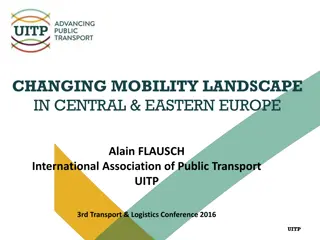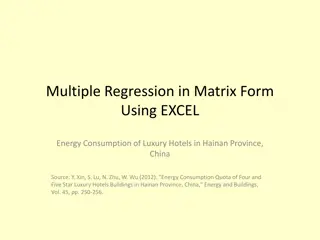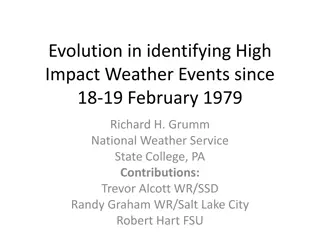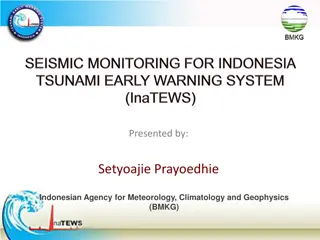Seismicity Analysis: Eastern Cape Province 1970-1979
Seismicity study focusing on re-evaluating earthquake epicenters, determining hypocenter depths, fault plane solutions, and seismic moment inversions. Data compiled from Seismology Unit of Council for Geosciences in South Africa.
Download Presentation

Please find below an Image/Link to download the presentation.
The content on the website is provided AS IS for your information and personal use only. It may not be sold, licensed, or shared on other websites without obtaining consent from the author.If you encounter any issues during the download, it is possible that the publisher has removed the file from their server.
You are allowed to download the files provided on this website for personal or commercial use, subject to the condition that they are used lawfully. All files are the property of their respective owners.
The content on the website is provided AS IS for your information and personal use only. It may not be sold, licensed, or shared on other websites without obtaining consent from the author.
E N D
Presentation Transcript
10th Inkaba yeAfrica/!Khure Africa (AEON) Conference/Workshop Lord Milner Hotel, Matjiesfontein - Karoo 29 September 3 October 2014 Seismicity of the Eastern Cape Province from 1970-1979 Mpho Mogoswane Department of Environmental, Water and Earth Sciences, Faculty of Science at Tshwane University of Technology, South Africa
OUTLINE Introduction Geology of the study area Seismicity before re-location Seismological stations Catalogue for Eastern Cape Methodology Results Geology and Seismicity after re-location Conclusion Recommendation References
Introduction Seismology is the study of earthquakes and seismic waves that move through and around the earth. Aim of study Re-evaluate the phase readings and re-locate the earthquake epicenters. Determine hypocenter depth of each earthquake using ray tracing (Chapman et al., 1988) to identify additional seismic phases after relocation. Determine fault plane solution through a grid search method (Snoke et al. 1988). Determine moment tensor solution time domain seismic moment inversion (Dreger, 2003) for earthquakes M>4.0.
Seismicity of the study area before re-location
Catalogue The data used for this study was obtained from Seismology Unit of Council for Geosciences which is responsible for the operation of the South African National Seismograph Network (SANSN). The database had 63 earthquakes on a period of 19 years. On this study only a period of 9 years is covered from 1970 to1979.
Catalogue Yearly Distribution
Methodology Searched earthquake bulletin from Council for Geoscience archive to compile the data, also used SANSD and ISC online catalogue . Seisan earthquake analysis software was used to process the data, version 9.0 (Havskov, 2011). Used software to plot and analysis of the earthquake data. Refined the original phase picks by re-picking seismic phases. Identify inaccurate phase readings (large time residuals and apply weighting identify timing errors). Re-locate the earthquake, find magnitude and depth determination. Fault plane mechanism (FOCMEC, FPFIT, HASH, INVRAD and PINV). Determined errors related to data.
Results B-Value B-Value is expressed by Gutenberg-Richter law (Log N=a-bM) which shows the relationship between the magnitude and total number earthquakes. Where; N is the number of events having a magnitude M a and b are constant. a=3.45 b=0.63
Error Ellipses Compiled from SANSD and ISC online catalogue. Error in location unacceptable (red big ellipses).
The Geology and Seismicity after re- location
Conclusions The Eastern Cape Province is not well endowed with large valuable deposits meaning less mines. Therefor most of seismic events occurring are naturally induced, which were caused by the movement of Cape Fold Belt from Cape Town extending to Eastern Cape Province. The information I gathered from this study can be used for seismic hazard and risk determination. Less events detected due to insensitive or absence of equipment.
Recommendation There is a need to compare historical seismic data of Eastern Cape with the present. This will improve the understanding of seismicity in the area. Better seismic station coverage is needed in the Eastern Cape to improve the quality of the data.
References Havskov, J and L. Ottem ller (2010). Processing earthquake data. Springer. Ottem ller, J and P. Voss and J. Havskov (2012), editors. SEISAN: The earthquake analysis software for Windows, SOLARIS, LINUX And MACKINTOSH Version 9.1. Manual, Department of Earth Science, University of Bergen, Norway. Saunders, I. 2005. South African National Seismograph Network FDSN 2005 Report. Chapman, C.H.C., Jen-Yi and Lyness, D.G., 1988. The WKBJ seismogram algorithm. In: Seismological Algorithms, edited by Doornbos, D.J. Academic Press, London.























